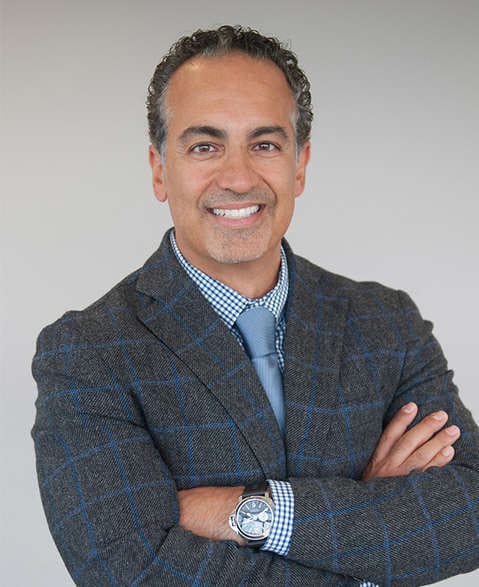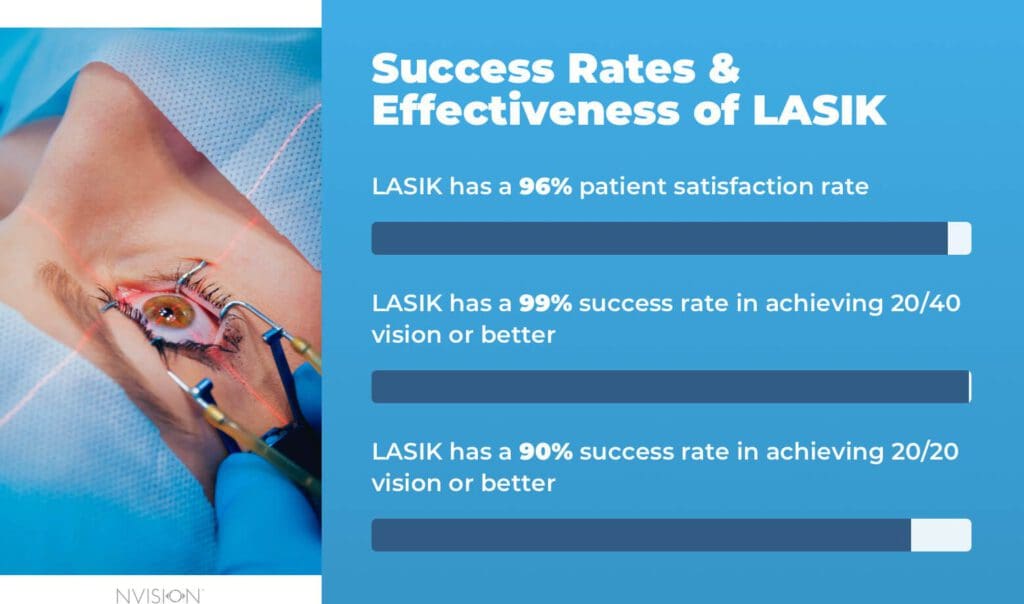
Medically Reviewed by Jonathan Pirnazar, M.D. NVISION Surgeon
LASIK Success Rate & Key LASIK Statistics
Last Updated:

Medically Reviewed by Jonathan Pirnazar, M.D. NVISION Surgeon

Article At a Glance
LASIK has a 99% success rate at NVISION, with most patients achieving 20/20 vision or better. Over 98% of patients report high satisfaction, with minimal complications. The procedure is safe, effective, and widely used by professionals like pilots and military personnel. With modern technology and expert surgeons, LASIK offers lasting vision improvement.
Table of Contents
What Is the Success Rate of LASIK?
The LASIK surgery success rate at NVISION is 99%. Advanced laser vision correction technology makes this elective procedure more effective than it’s ever been before.
People often opt for LASIK eye surgery to reduce their reliance on glasses or contact lenses. But for some, laser eye surgery is a mandatory part of keeping a job.
You deserve clear vision. We can help.
With 135+ locations and over 2.5 million procedures performed, our board-certified eye surgeons deliver results you can trust.
Your journey to better vision starts here.
For example, some pilots use LASIK to ensure they can handle the demands of flying an aircraft. In one study of efficacy, 100% of pilots treated with LASIK had uncorrected distance vision of 20/20.[1] They didn’t just reduce their reliance on glasses or contacts. They no longer needed them

How Is the LASIK Success Rate Measured?
Some researchers use clinical outcomes, such as vision tests, to measure LASIK outcomes. But others say patient satisfaction is a core part of LASIK success rates.[3] When people are pleased with the results of their LASIK eye surgery, their opinion counts.
LASIK Eye Surgery Outcomes
Most patients undergo LASIK to address vision problems like nearsightedness or farsightedness. Their vision goals might be reducing the need to wear glasses while driving or reading. Their doctors can use these metrics to determine whether the LASIK procedure was successful or not.
To determine a LASIK success rate, doctors might assess visual acuity (or the sharpness of vision) both before and after the procedure. LASIK surgery can help correct myopia, also known as nearsightedness. Hyperopia (farsightedness) can also be corrected with LASIK eye surgery, as can astigmatism. Improvement in these refractive errors means the surgery worked.
Measuring lingering side effects of the surgical procedure, as well as determining patient satisfaction as the eyes heal, can also provide important clues.
What Is the LASIK Satisfaction Rate for Most Patients?
The current LASIK patient satisfaction rate is higher than 96%.[2] Few patients experience vision problems or other issues caused by laser vision correction surgery. When asked about their decision to have surgery, very few patients regret it.
Setting appropriate goals is an important part of ensuring a high satisfaction rate. For example, people who are aware that LASIK can’t correct age-related vision changes aren’t unhappy when those issues appear years later.
But some people experience benefits they never anticipated. For example, people who spend a significant amount of money every month on contact solutions and maintenance might be delighted with their cost savings after LASIK surgery.
Notable LASIK Eye Surgery Success Statistics
- More than 98% of LASIK patients are satisfied or very satisfied with their sight after surgery.[4]
- In a study of 58,653 LASIK procedures, less than 1% of patients lost two lines of best-corrected visual acuity.[2]
- In a study of 107 military members, the vast majority reported significantly less difficulty in performing daily activities after surgery.[3]
- In a study of physicians who had LASIK, the satisfaction rate was 98.3%. Close to 97% said they would have the procedure again.[5]
LASIK Complication Rate
Experts say LASIK complications are so unusual that a busy surgeon might have only one or two of these cases to manage during an entire year.[6]
After refractive surgery, your eyes must heal. Side effects, such as dry eyes, are common. But true complications that could harm your long-term vision are rare.
The current LASIK procedure complication rate is less than 1%.[7] Patients who listen closely to their doctors and follow proper follow-up procedures have the best outcomes, including low risk of complications. Using eye drops and taking medications as directed can help your eyes heal as quickly as possible.
Postoperative Vision Corrective Surgery Complications
While people might experience some side effects while their eyes heal, few experience true surgery complications.
Some known LASIK complications include the following:
- Overcorrection or undercorrection: A programming error could mean taking off too much or too little tissue.
- Visual aberrations: Higher order aberrations can lead to bothersome vision difficulties your doctor can fix with glasses or contact lenses.
- Flap issues: When your eyes don’t heal after surgery (macrostriae and microstriae), visual problems can appear.
- Visual disturbances: Haloes, glare, and starbursts are typical side effects after surgery. If they persist, they’re considered complications.
- Dry eye: As eye tissues heal, they may feel dry and gritty. If dry eye persists, it’s called a complication.
LASIK Blindness Rate
LASIK has never been connected to blindness. Researchers say it’s never been considered a primary and exclusive cause of blindness.[2]
Patients should not worry about going blind from LASIK. This is simply not a side effect that takes place.
You deserve clear vision. We can help.
With 135+ locations and over 2.5 million procedures performed, our board-certified eye surgeons deliver results you can trust.
Your journey to better vision starts here.
LASIK Failure Rate
LASIK is a safe and effective laser vision correction surgery with a complication rate of less than 1%.[7] It’s extremely rare for the surgery to truly fail and leave patients worse than they were before the procedure was complete.
Given its very low failure rate, LASIK’s popularity has grown increasingly over the years.
How to Improve Your Chances of LASIK Surgery Success
Your doctor has a lot of control over your LASIK success rate, but your hard work matters too. The steps you take before and after laser vision correction surgery have a strong impact on how well you heal.
Before surgery, take the following steps:
- Play an active role in your overall health and eye health.
- Educate yourself on laser vision correction and decide if a vision correction procedure is right for you.
- Find a successful LASIK surgeon to assist you.
While you’re recovering from LASIK, take the following steps:
- Limit certain activities, such as driving, exercising, and outdoor activities.
- Avoid rubbing your eyes.
- Keep water out of your eyes.
- Follow your doctor’s instructions.
- Keep all follow-up appointments.
Other factors that could impact LASIK’s success rate include the following:
- Advanced technology: Modern lasers make extremely precise incisions following custom-made maps of your eye’s surface. With current technology, including the femtosecond laser for creating the flap and topography-guided laser treatments, all complications can usually be treated. The procedure has become extremely safe.
- Your medical team: Your doctor’s expertise matters. NVISION surgeons have performed more than 2 million surgical procedures. One of our NVISION surgeons has performed more than 150,000 LASIK procedures with no infections resulting from the procedure. Not one patient has lost vision from LASIK surgery.
With current technology, including the femtosecond laser for creating the flap and topography-guided laser treatments, nearly all LASIK complications can be treated.
Is LASIK Worth It?
With a high LASIK success rate and few vision problems after surgery, most LASIK patients are pleased with the results and their decision to have their vision corrected.
If you’re healthy enough to have surgery and want to reduce your reliance on contacts and glasses, surgery can be a good option. In fact, in head-to-head studies, researchers say people who have LASIK are more satisfied with contact lens wear. They have fewer episodes of dry eye too.[8]
Considering LASIK? Take our LASIK Candidate Quiz.
You deserve clear vision. We can help.
With 135+ locations and over 2.5 million procedures performed, our board-certified eye surgeons deliver results you can trust.
Your journey to better vision starts here.
References
- Reinstein D, Ivory E, Chorley A. PRESBYOND laser blended vision LASIK in commercial and military pilots requiring Class 1 medical certification. Journal of Refractive surgery. 2023;39(1):6–14. https://doi.org/10.3928/1081597X-20221129-02.
- Is LASIK safe? What you need to know. Refractive Surgery Council. Published October 13, 2022. Accessed September 11, 2023. https://americanrefractivesurgerycouncil.org/is-lasik-safe/
- Sia R, Ryan D, Stutzman R, Pasternak J, Eaddy J, Logan L, Rivers B, Bower K. Wavefront-guided and Wavefront-optimized LASIK: Visual and military task performance outcomes. Military Medicine. 2021;186(7-8):714-719. https://doi.org/10.1093/milmed/usaa507
- Bamashmus MA, Hubaish K, Alawad M, Alakhlee H. Functional outcome and patient satisfaction after laser in situ keratomileusis for correction of myopia and myopic astigmatism. Middle East Afr J Ophthalmol. 2015;22(1):108-114. https://doi.org/10.4103/0974-9233.148359
- Ma J, Pillar A, Ronald K. Quality of life and satisfaction among physicians after wavefront-optimized vs topography-guided laser vision correction. Journal of Cataract and Refractive Surgery. 2020;46(11):1466*1743. https://doi.org/10.1097/j.jcrs.0000000000000301
- LASIK complications and LASIK eye surgery risks. Refractive Surgery Council. Published October 13, 2022. Accessed September 11, 2023. https://americanrefractivesurgerycouncil.org/lasik-complication-rate-side-effects/
- LASIK complications and LASIK eye surgery risks. Refractive Surgery Council. Published October 13, 2022. Accessed September 11, 2023. https://americanrefractivesurgerycouncil.org/lasik-complication-rate-side-effects/
- Price MO, Price DA, Bucci FA Jr, Durrie DS, Bond WI, Price FW Jr. Three-Year Longitudinal Survey Comparing Visual Satisfaction with LASIK and Contact Lenses. Ophthalmology. 2016;123(8):1659-1666. https://doi.org/10.1016/j.ophtha.2016.04.003

Dr. Pirnazar is known as the one of the best LASIK surgeons in Orange County, California. Having performed over 55,000 refractive and cataract surgeries, Dr. Pirnazar’s specialties include LASIK, PRK and cataract surgery. Thanks to his expertise, Dr. Pirnazar and his partners at NVISION were selected to be the official team ophthalmologists for the Los Angeles Chargers.
This content is for informational purposes only. It may have been reviewed by a licensed physician, but is not intended to serve as a substitute for professional medical advice. Always consult your healthcare provider with any health concerns. For more, read our Privacy Policy and Editorial Policy.

